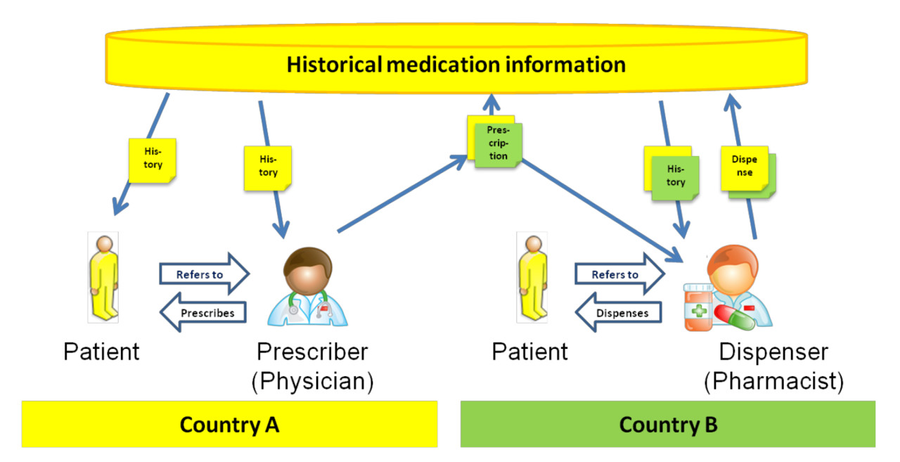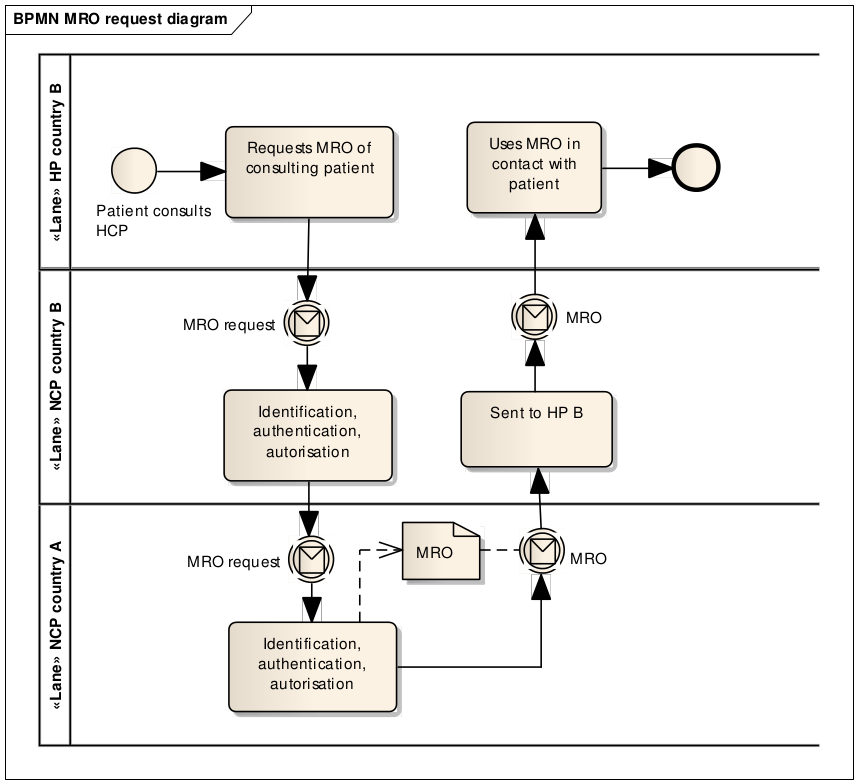Medication Related Overview
The purpose of this page is to provide a better clarification on the specification of the implementation of the Medication Related Overview Service on the OpenNCP scope.
______________________________
MRO Service Implementation Overall Status
1. Scenario Clarification
Purpose
The overall purpose to be achieved by this use case is to enable a foreign HCP to review the medical information of a patient consulting her, thereby securing an updated and more safe further treatment of the patient.
Use Case Actors
The actors involved in the epSOS MRO Use Case are:
Primary actors:
- The Patient
- A Prescriber
- A Dispenser
Secondary actors:
- Patient identification, authentication & role authorization service;
- The epSOS Patient Access translation service;
Diagram 1: Use case diagram
The following diagram illustrates the basic use case for the MRO service.
Figure 1. Process diagram of the medication distribution 2 (eP and eD) + distribution II (medication related overview).
Basic explanation of the Use case
- The patient, who is referred to (or reports himself to) a physician.
- When the decision is made that the patient has to take medication for treatment the physician, in his role as prescriber, issues a medication prescription that can be seen both as an order to a pharmacist as well as the agreement between the physician and the patient on the specific treatment with this medication. For doing this, the prescriber receives relevant historical medication information.
- The pharmacist, in his role as a dispenser of medication, receives the prescription, in some countries he receives relevant historical medication information, and dispenses the medication. The pharmacist then issues information about the dispensation, which serves two goals: it is added to the historical medication information, and it is used to update the status of the prescription (in some cases it lowers the amount of remaining items that can be given out from the prescription). The patient again, finally, receives the medication and takes care of the administration, with or without the intervention of family members and/or nurses.
2. Requirements
Service State diagram
Non-Functional Requirements
For Non-Functional requirements please consult the D 1.4.3, page 71;
Legal Requirements
For service legal requirements please consult the D 1.4.3, page 67;
Security Requirements
For service security requirements please consult the D 1.4.3, page 68;
Clinical Requirements
For service clinical requirements please consult the D 1.4.3, page 69.
Additional Architecture NCP / Central Service requirements
For additional Architecture NCP / Central Service requirements please consult the D 1.4.3, page 72.
3. Implementation Strategy Design
Overview
The chosen implementation strategy will make use of the existent Arquitecture and implemented profiles. Following you can fin a table that maps the required steps, in order to accomplish this service and the behaviour that will occur within the OpenNCP system.
Proposed Solution
| Step | Actions | OpenNCP actions and operations description | To be implemented in the OpenNCP | Related Profiles |
|---|---|---|---|---|
| 1 | Health professional identification and authentication |
| Already supported | XUA |
| 2 | The patient’s identity has to be validated in country B, the patient’s identifier(s) from country A must be used for retrieving the MRO. |
| Already supported | XCPD |
| 3 | The patient must agree with sending the MRO to country B (patient consent in country A). |
| Already supported, some light adjustment is needed. | XCA |
| 4 | Country B requests the MRO from country A. Country A processes this request and sends the MRO to country B. |
| Already supported, some adjustments are required in the client and server part, mostly at the NI interface level. The portal also requires some changes in order to dispolay the MRO correctly. | XCA |
4. Implementation Issues / Tasks
Portal-B
Protocol Terminators
4. Testing Strategy
Regarding the testing strategy, the following topics need to be covered:
- Extend integration testing for both CLIENT and SERVER part;
- Add extra validation in CI environment;
Related issues
5. Documentation and References
Documents
Sample MRO Documents

